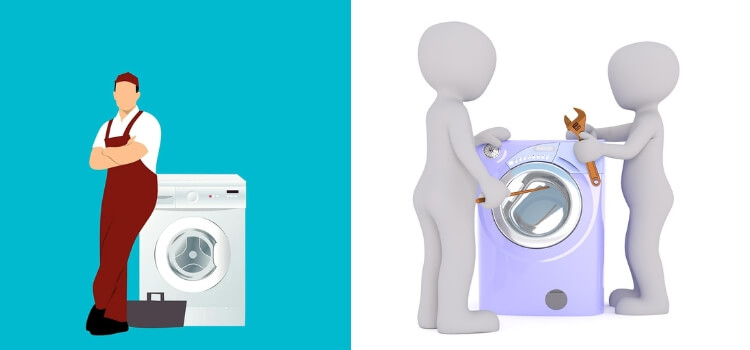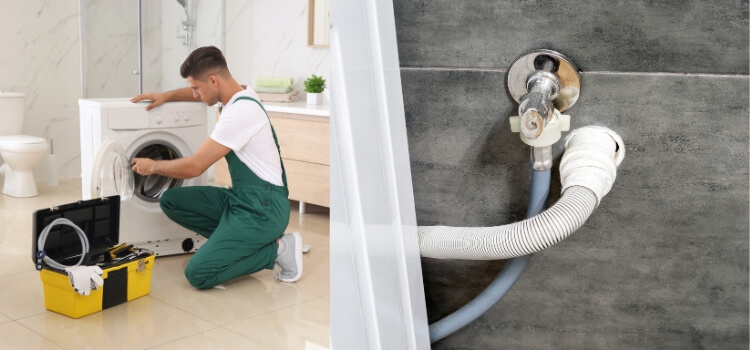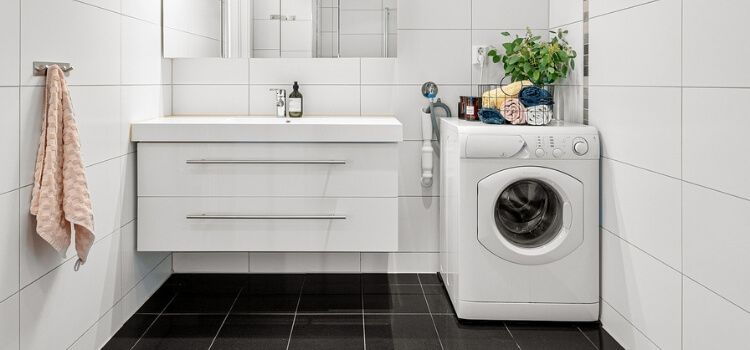As an Amazon Associate, I earn from qualifying purchases
To vent a washing machine drain pipe, install a standpipe and connect it to the home’s vent system. Ensure proper sealing and adequate slope for proper drainage.
When venting a washing machine drain pipe, it’s essential to do it properly to prevent sewer gas and water backup in the laundry area. Installing a standpipe allows for proper venting, and connecting it to the home’s vent system ensures effective drainage.
Sealing the connections tightly is important and ensuring the standpipe has the right slope for water flow. By following these steps, you can effectively vent your washing machine drain pipe and avoid potential issues in the future. Proper venting is crucial for a washing machine’s drainage system to function efficiently. Let’s explore the essential steps and considerations for venting a washing machine drain pipe to ensure a well-maintained and trouble-free laundry area.

Importance Of Proper Venting
Proper venting of a washing machine drain pipe is crucial for maintaining the efficiency and integrity of your laundry system. The importance of proper venting cannot be overstated, as it directly impacts your washing machine’s drainage, performance, and longevity. This section will delve into the significance of ensuring a well-vented washing machine drain pipe.

Preventing Drainage Issues
Adequate venting of the washing machine drain pipe is pivotal in preventing drainage issues such as clogs and slow draining. Without proper venting, air can become trapped in the drain pipe, leading to water backing up and causing blockages. This can result in inconvenience and potential damage to the washing machine and surrounding areas.
Maintaining Performance
Proper venting is essential for maintaining the optimal performance of the washing machine. When the drain pipe is inadequately vented, it can lead to sluggish drainage, affecting the machine’s ability to expel water effectively. This can result in longer cycle times and subpar cleaning results, ultimately impacting the machine’s performance and efficiency.
Choosing The Right Location
When it comes to venting a washing machine drain pipe, one of the crucial decisions you need to make is choosing the right location. This step is essential to ensuring that your washing machine runs smoothly without any issues. Considering factors such as accessibility and avoiding blockages will help you determine the best spot to vent your washing machine drain pipe. Let’s explore these aspects in more detail:

Considering Accessibility
Accessibility is a key factor when selecting the location for venting your washing machine drain pipe. Easy access saves time, effort, and frustration in case any maintenance or repair work becomes necessary. The ideal location should be easily reachable without any obstacles to hinder access. Additionally, ensure that the area surrounding the vent pipe is clear of any clutter or obstructions. This way, you can conveniently inspect and clean the vent pipe as needed, thus promoting efficient drainage for your washing machine.
Avoiding Blockages
Another essential aspect to remember when choosing the location for venting your washing machine drain pipe is to avoid potential blockages. Place the vent pipe in a location where debris or other objects are less likely to obstruct it. If the vent pipe gets clogged, it can lead to unpleasant odors, slow drainage, or even backups. Consider placing the vent pipe away from trees, bushes, or any other dirt or debris sources that could block the pipe. By taking these precautions, you can prevent costly plumbing issues in the future and maintain the proper functioning of your washing machine drain pipe.
Materials Needed
To properly vent a washing machine drain pipe, you must gather the necessary materials before starting the installation process. Having the right materials on hand will ensure a smooth and efficient installation that meets plumbing regulations and prevents any potential issues down the line.

Pvc Pipes
When venting a washing machine drain pipe, the primary material you’ll need is PVC pipes. These pipes are durable, corrosion-resistant, and easy to work with. Due to their affordability and availability, they are also the most commonly used material for plumbing projects.
Fittings And Connectors
To assemble the vent system, you’ll need fittings and connectors in addition to PVC pipes. These components ensure a secure and leak-free connection between the pipes. Common fittings and connectors include elbows, tees, couplings, and adapters specifically designed for PVC pipes.
Steps To Vent The Washing Machine Drain Pipe
If you want to ensure that your washing machine drain pipe is properly vented, you can follow a few simple steps. You can easily vent the washing machine drain pipe by locating the drain pipe, measuring and cutting pipes, and assembling the vent system. Let’s take a closer look at each step:
Locating The Drain Pipe
The first step to venting your washing machine drain pipe is to locate the existing drain pipe. This is typically found near the back of the washing machine, where the drain hose is connected. Take a moment to inspect the area and find the existing pipe visually.
Measuring And Cutting Pipes
Once you have located the drain pipe, it’s time to measure and cut the necessary pipes for the vent system. You must determine the length of the new pipe that will connect to the existing drain pipe and extend vertically to the desired height. Use a tape measure to measure the length and mark the pipe accurately.
Next, carefully cut the pipe at the marked location using a pipe cutter or a hacksaw. Make a clean, straight cut to ensure a proper fit when assembling the vent system.
Assembling The Vent System
With the pipes measured and cut, it’s time to assemble the vent system. Begin by attaching a PVC elbow fitting to the cut end of the existing drain pipe. Using PVC primer and cement, ensure a secure connection.
Next, attach the vertical pipe to the other end of the elbow fitting, extending it to the desired height. Secure the connection using PVC primer and cement as well. This vertical pipe will act as the main vent for the washing machine drain pipe.
Add pipes and fittings to extend the vent system and ensure proper ventilation if needed. Just be sure to use PVC primer and cement to secure all connections.
Once the vent system is assembled, test it for proper airflow by running water through the washing machine drain pipe. Check for any leaks or loose connections and make any necessary adjustments.
That’s it! Following these steps, you can easily vent your washing machine drain pipe and ensure proper drainage. Always adhere to local plumbing codes and consult a professional if unsure about any aspect of the installation process.
Connecting To Existing Plumbing
When connecting a washing machine drain pipe to existing plumbing, ensuring proper venting for efficient drainage is crucial.
Tying Into Vent Stacks
Connect your washing machine drain pipe to the existing vent stack for adequate air flow.
- Locate the nearest vent stack to tie into.
- Cut into the vent stack using a pipe cutter.
- Securely fasten the washing machine drain pipe to the vent stack with appropriate fittings.
Integrating With Ventilation Systems
Ensure your washing machine drain pipe integrates seamlessly with the existing ventilation system.
- Check the ventilation system’s capacity to accommodate the additional load.
- Install inline vents if necessary to prevent air pressure issues.
- Test the system to verify proper ventilation before regular use.
Testing The Ventilation System
Checking For Proper Airflow
Inspect the washing machine drain pipe for any blockages or restrictions.
Ensuring Drainage Functionality
Run a test load in the washing machine to ensure proper drainage.
Maintenance Tips
Maintaining your washing machine drain pipe is essential to ensure your appliance functions properly and to avoid potential plumbing issues. Here are some important maintenance tips to keep in mind:

Regular Inspections
Regularly inspecting your washing machine drain pipe is crucial to identify any potential issues before they escalate. Look for any signs of leaks, blockages, or damage to the pipe, and address them promptly to prevent further problems.
Clearing Debris
Removing debris from the washing machine drain pipe is essential to maintaining smooth water flow and preventing clogs. Regularly check for any accumulated lint, dirt, or other obstructions, and clear them to ensure unrestricted drainage.
Common Mistakes To Avoid
To properly vent a washing machine drain pipe, ensure it is positioned at the correct height to prevent backups and odors. Avoid common mistakes like improper installation, inadequate slope, or using a too small vent, which can lead to drainage issues and costly repairs.
Ensure proper ventilation to maintain the efficiency of your washing machine drainage system.
When it comes to venting a washing machine drain pipe, people often make certain common mistakes. These mistakes can lead to various issues, such as clogs, slow draining, or even damage to the washing machine. To avoid these problems, it is important to be aware of the following common mistakes and take the necessary precautions:
Improper Slope
One of the most common mistakes people make when venting a washing machine drain pipe is not ensuring the proper slope. The drain pipe needs a slight slope to allow the water to flow freely. Neglecting this requirement can result in stagnant water, leading to clogs and foul odors. It is essential to ensure the drain pipe has a slope of at least 1/4 inch per foot, directing the water towards the main drain.
Neglecting ventilation Requirements
Another mistake to avoid is neglecting the vent requirements for the washing machine drain pipe. Proper venting is crucial to prevent airlocks and allow smooth water flow. An improperly vented drain pipe may cause water to back up, resulting in slow draining and potential damage to the washing machine. Ensure that the drain pipe is adequately vented according to local plumbing codes. This will help maintain proper water flow and prevent any unwanted issues.

Frequently Asked Questions
Yes, a washing machine drain line needs to be vented to prevent sewage gas buildup.
Local plumbing codes are typically what determine the code for a washing machine drain. It usually involves using a P-trap and ensuring proper ventilation. Check your local building codes for specific requirements.
You should vent a washer standpipe above the trap, typically within 6 inches but check local codes for specific requirements.
No, wet venting a washer drain is not recommended as it may lead to plumbing issues. It’s best to have a dedicated vent for the washer drain to prevent problems.
Conclusion
Venting your washing machine drain pipe is crucial for preventing odors and clogs. By following the steps outlined in this guide, you can ensure proper ventilation and maintain the efficiency of your washing machine. With a well-vented drain pipe, you can enjoy hassle-free laundry days and peace of mind.
As an Amazon Associate, I earn from qualifying purchases
Leave a Reply